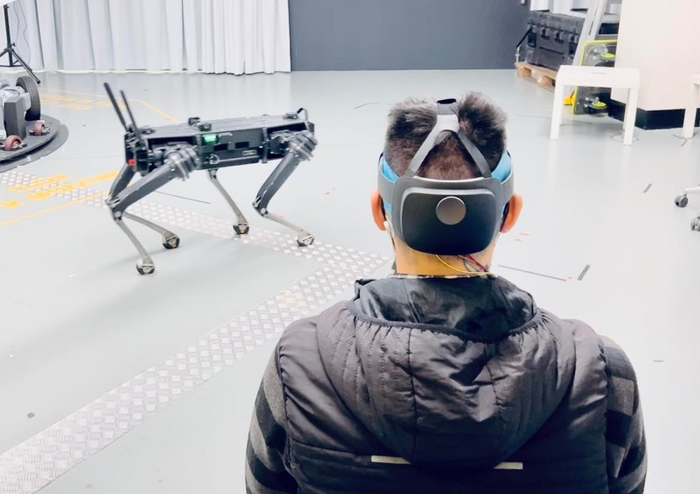It sounds like something from science fiction: Don a specialized, electronic headband and control a robot using your mind. But now, recent research published in ACS Applied Nano Materials has taken a step toward making this a reality. By designing a special, 3D-patterned structure that doesn’t rely on sticky conductive gels, the team has created “dry” sensors that can measure the brain’s electrical activity, even amidst hair and the bumps and curves of the head.

Credit: Adapted from ACS Applied Nano Materials, 2023, DOI: 10.1021/acsanm.2c05546
It sounds like something from science fiction: Don a specialized, electronic headband and control a robot using your mind. But now, recent research published in ACS Applied Nano Materials has taken a step toward making this a reality. By designing a special, 3D-patterned structure that doesn’t rely on sticky conductive gels, the team has created “dry” sensors that can measure the brain’s electrical activity, even amidst hair and the bumps and curves of the head.
Physicians monitor electrical signals from the brain with electroencephalography (EEG), in which specialized electrodes are either implanted into or placed on the surface of the head. EEG helps diagnose neurological disorders, but it can also be incorporated into “brain-machine interfaces,” which use brain waves to control an external device, such as a prosthetic limb, robot or even a video game. Most non-invasive versions involve the use of “wet” sensors, which are stuck onto the head with a gloopy gel that can irritate the scalp and sometimes trigger allergic reactions. As an alternative, researchers have been developing “dry” sensors that don’t require gels, but thus far none have worked as well as the gold-standard wet variety. Although nanomaterials like graphene could be a suitable option, their flat and typically flaky nature make them incompatible with the uneven curves of the human head, particularly over long periods. So, Francesca Iacopi and colleagues wanted to create a 3D, graphene-based sensor based on polycrystalline graphene that could accurately monitor brain activity without any stickiness.
The team created several 3D graphene-coated structures with different shapes and patterns, each around 10 µm thick. Of the shapes tested, a hexagonal pattern worked the best on the curvy, hairy surface of the occipital region — the spot at the base of the head where the brain’s visual cortex is located. The team incorporated eight of these sensors into an elastic headband, which held them against the back of the head. When combined with an augmented reality headset displaying visual cues, the electrodes could detect which cue was being viewed, then work with a computer to interpret the signals into commands that controlled the motion of a four-legged robot — completely hands-free. Though the new electrodes didn’t yet work quite as well as the wet sensors, the researchers say that this work represents a first step toward developing robust, easily implemented dry sensors to help expand the applications of brain-machine interfaces.
The authors acknowledge funding from the Defence Innovation Hub of the Australian Government and support from the Australian National Fabrication Facility of the University of Technology Sydney and the Research & Prototype Foundry at the University of Sydney Nano Institute.
The American Chemical Society (ACS) is a nonprofit organization chartered by the U.S. Congress. ACS’ mission is to advance the broader chemistry enterprise and its practitioners for the benefit of Earth and all its people. The Society is a global leader in promoting excellence in science education and providing access to chemistry-related information and research through its multiple research solutions, peer-reviewed journals, scientific conferences, eBooks and weekly news periodical Chemical & Engineering News. ACS journals are among the most cited, most trusted and most read within the scientific literature; however, ACS itself does not conduct chemical research. As a leader in scientific information solutions, its CAS division partners with global innovators to accelerate breakthroughs by curating, connecting and analyzing the world’s scientific knowledge. ACS’ main offices are in Washington, D.C., and Columbus, Ohio.
To automatically receive news releases from the American Chemical Society, contact [email protected].
Follow us: Twitter | Facebook | LinkedIn | Instagram
Journal
ACS Applied Nano Materials
DOI
10.1021/acsanm.2c05546
Article Title
“Noninvasive Sensors for Brain−Machine Interfaces Based on Micropatterned Epitaxial Graphene”
Article Publication Date
16-Mar-2023




